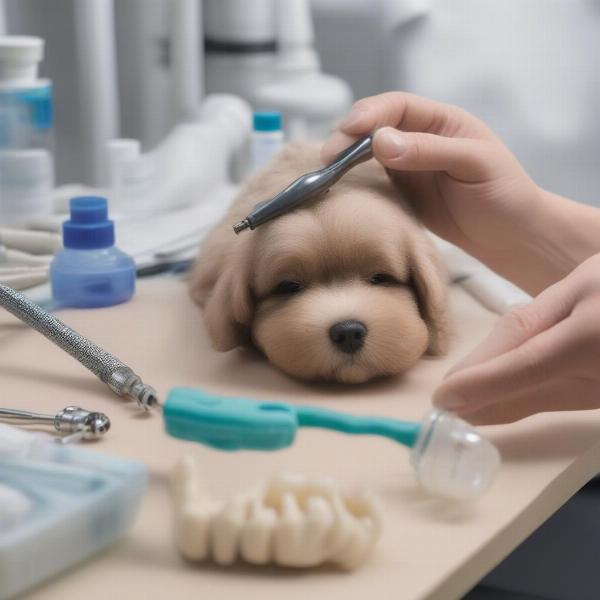Urethral prolapse in dogs, a condition where the inner lining of the urethra protrudes through the urethral opening, is most commonly seen in intact male dogs, although it can occasionally occur in females. This article will explore the causes, symptoms, and treatment options for urethral prolapse in dogs, offering practical advice for concerned owners. Understanding this condition is crucial for ensuring the well-being of your canine companion.
Brachycephalic breeds like English Bulldogs and Pugs are predisposed to urethral prolapse. Excessive straining during urination, often associated with urinary tract infections, bladder stones, or constipation, can also contribute to the development of this condition. Hormonal influences, particularly in intact males, play a significant role, as testosterone can enlarge the prostate gland, increasing pressure on the urethra.
Recognizing the Signs of Urethral Prolapse in Your Dog
A noticeable, donut-shaped mass of reddish tissue protruding from the tip of the penis is the primary symptom of urethral prolapse. This protruding tissue can vary in size and may bleed, causing bloody urine or spotting on bedding. Your dog might also lick the area excessively due to irritation and discomfort. If you observe any of these signs, immediate veterinary attention is crucial to prevent complications like infection or urinary obstruction.
When to Seek Veterinary Care for Urethral Prolapse
While some cases of urethral prolapse may resolve spontaneously, it’s always best to consult a veterinarian for an accurate diagnosis and appropriate treatment plan. Prompt veterinary intervention can help minimize the risk of complications. Delaying treatment can lead to further complications such as tissue necrosis or infection. urethral prolapse in dogs If your dog exhibits any signs of discomfort or distress, seek immediate veterinary care.
Treatment Options for Urethral Prolapse in Dogs
Treatment for urethral prolapse varies depending on the severity of the condition. In mild cases, topical medications and antibiotics may be sufficient to reduce inflammation and prevent infection.  Treating Urethral Prolapse in a Dog More severe cases may require surgical intervention, which can involve either reducing the prolapse and suturing it in place or performing a urethrostomy to create a new opening for urination. Castration is often recommended for intact male dogs to prevent recurrence.
Treating Urethral Prolapse in a Dog More severe cases may require surgical intervention, which can involve either reducing the prolapse and suturing it in place or performing a urethrostomy to create a new opening for urination. Castration is often recommended for intact male dogs to prevent recurrence.
Post-Operative Care and Long-Term Management
Following surgical intervention, your dog will likely require Elizabethan collars to prevent licking and self-trauma. Pain medication and antibiotics will help manage discomfort and prevent infection. Regular monitoring and follow-up appointments with your veterinarian are essential to ensure proper healing and address any potential complications. prolapsed urethra dog Long-term management may involve dietary changes to prevent constipation and maintain urinary health.
“Urethral prolapse is often associated with hormonal influences in male dogs,” says Dr. Emily Carter, DVM, a leading veterinary specialist in canine urology. “Therefore, castration is typically recommended to address the underlying hormonal factors and prevent recurrence.”
Preventing Urethral Prolapse
While not all cases of urethral prolapse are preventable, certain measures can help reduce the risk, especially in predisposed breeds. Maintaining good urinary health through a balanced diet and adequate hydration is crucial. Prompt treatment of urinary tract infections and other urinary issues can also help prevent excessive straining during urination. urethral prolapse in male dogs “Regular check-ups are vital for early detection and prompt management of urinary problems,” adds Dr. Carter. “This is especially important for breeds known to be susceptible to urethral prolapse.”
In conclusion, urethral prolapse in dogs is a condition that requires prompt veterinary attention. By understanding the causes, symptoms, and treatment options, you can play a proactive role in ensuring your dog’s health and well-being. Early intervention and appropriate management are key to a positive outcome and can significantly improve the quality of life for affected dogs. prolapsed urethra in dogs
FAQ:
- What is the most common sign of urethral prolapse in dogs? A reddish, donut-shaped mass protruding from the penis tip.
- Which dogs are most susceptible to urethral prolapse? Intact male dogs, particularly brachycephalic breeds.
- Is urethral prolapse a medical emergency? While not always an immediate emergency, it requires prompt veterinary attention.
- Can urethral prolapse be treated without surgery? Mild cases may respond to medication, but severe cases often require surgery.
- What is the long-term prognosis for dogs with urethral prolapse? With appropriate treatment and management, the prognosis is generally good.
- How can I prevent urethral prolapse in my dog? Maintaining good urinary health, prompt treatment of urinary issues, and castration in males can help reduce the risk.
- What should I do if I suspect my dog has a urethral prolapse? Contact your veterinarian immediately for diagnosis and treatment.
ILM Dog is your trusted resource for comprehensive information and expert advice on dog care, breed selection, health, training, nutrition, grooming, and much more. We offer practical guidance and valuable insights to help you provide the best possible care for your furry friend. From puppy care to senior dog care, and even tips on traveling with your dog, ILM Dog covers all aspects of responsible dog ownership. Contact us today for personalized support and expert advice on all your dog-related needs. Email: [email protected], Phone: +44 20-3965-8624.